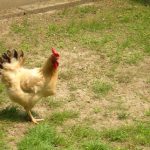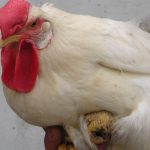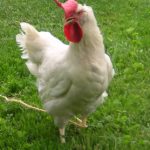Name
White Saluzzo Hen, Light Bionda Piemontese Hen
Seal of quality
Typical food-farming product (PAT). Slow food
Description
White, Saluzzo Hen
A small-medium sized hen with a red crest consisting of 4-6 teeth, which are erect in the cock and hanging in the female. The jowls and cheeks are red, while the peak if yellow, almost the same colour as the skin. The plumage is of a pearly white colour with a tail of the same colour which is kept raised and slightly open in the hen. The weight of adult hens ranger from between 1,9 and 2,4 kg, while that of adult females are from between 1,7 and 2,2 kg.
This variety is quite productive in terms of egg laying, the eggs being of a shiny white colour, and having a smooth shell and average weight of 50 grams.The quality of its meat, thanks also to the breeding technique used and intensive feeding, is excellent and therefore suited to the most demanding consumers. The typical productions being the 60-70 day old chicken, capons during the Christmas period and the Hen at the end of production, The well developed jowls and cheeks are used to make the “finanziera”, a typical Piemontese dish.
Piemontese Blonde Hen
A medium-sized variety with well developed shoulders and breast. Head of medium size with a crest with 4 or 6 dents, which is erect in the cock and which hang laterally in the hen. Jowls and cheeks are red, while the beak and skin are yellow. The plumage is fairly variegated, with colours ranging from blonde to taupe in different shades. With a high tail which is black in the hen and blue or white in the cock. The weight of the adult cock varies from between approximately 2.5 and 3 Kg , while in adult hens it is of between 2 and 2,5 Kg.
This breed has good egg production capacity, the eggs being of a pinkish colour with a smooth shell and an average weight of between 55-60 grams.The fact that these birds are free range and fed using foodstuffs based on corn and simple staples means that their meat is particularly appreciated. The typical production being chickens of between 60-70 days, the capon during the Christmas period and the Hen at the end of production. The well developed cheeks and jowls being used to make the “finanziera”, a typical Piedmontese dish.
Area of production
White, Saluzzo Hen: comunes of Barge, Bagnolo, Cavallermaggiore, Costigliole, Moretta, Paesana, Racconigi, Revello, Saluzzo, Sanfront, Savigliano, Scarnafigi, Venasca, Villafalletto, Verzuolo, Villanova Solaro (Province of Cuneo^); comunes of Cavour, Garzigliana ande surrounding areas (Province of Turin).
Piemontese Blonde Hen: The entire area of the provinces of Cuneo, Asti and Turin.
History
The Bianca di Saluzzo breed was common in the Saluzzo area, which at one time belonged to the Marquisate of Saluzzo, as well as the zone bordering the province of Turin (Cavour, Garzigliana, Villafranca etc.).Particularly the commune of Cavour, which at one time housed an important poultry market, the breed has maintained a significant presence in the local farms and estates, so much so that the Bianca di Saluzzo is sometimes called the Bianca di Cavour. The local Piedmontese breeds were famous up until 50 years ago and the markets and trade fairs held in our Region attracted traders from all over Italy. In the 1800’s, 50% of the retail production output of the local farms consisted of poultry. The hens were raised in the farmyards and those destined for laying eggs and meat were then taken to the local markets and sold by the womenfolk, while the proceeds of the sales were used to purchase the products that were not produced at the farm such as sugar, coffee, salt and oil.
During the course of recent decades the Bianca di Saluzzo has been replaced by industrial bred birds which is based of a rapid- growth breed, that gives meat with little taste, and which are not suited to free range raising. The restoration of the Bianca di Saluzzo and of the Bionda Piemontese breeds dates back to the end of 1999 thanks to the proposal by Slow Food to adopt protective measures in forming part of a project aimed at enhancing the value of products of excellent organoleptic quality but which risk extinction. Starting from the residual remains of these breeds found in the country, a selection and diffusion process of these birds was initiated.


